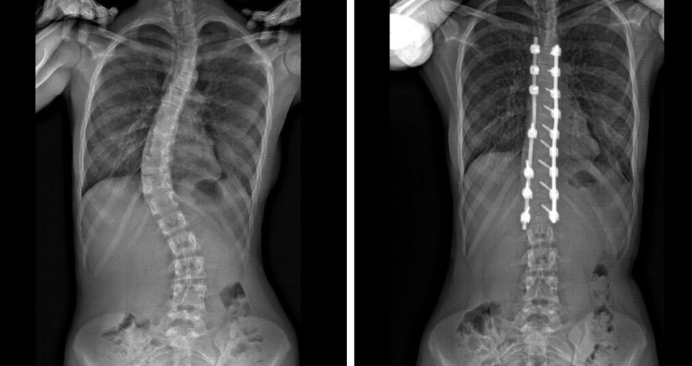Scoliosis
Scoliosis, not to be confused with silicosis, is a condition that causes a sideways curvature of the spine and affects around 3 percent of the population in the United States. While spines are naturally curvy, when viewed from the back, a typical spine will appear straight. Those with scoliosis, however, will usually develop a S-shaped or C-shaped curvature. This condition, although the exact cause is unknown, usually develops in adolescents, being especially prominent in females. It can be attributed to a variety of factors including genetics, family history, growth imbalances, being a byproduct of another disease, genetic disorder, or trauma.
Symptoms include uneven shoulders or hips, more prominent shoulder blades, back pain, and in some cases, breathing problems. When healthcare professionals diagnose this condition, a normal procedure would include an evaluation of family history, a physical exam, and an x-ray. Through this, doctors can best judge its severity and what a suitable treatment would be. If the condition is mild, the patient may only be subjected to regular checkups and observation in case of further progression, which is common especially among pre-pubescents. If the condition is moderate–around 20 to 40 degrees– the patient will be advised to wear a back brace, which prevents the spine from further progressing. In some cases, the back brace may even reverse the curvature of the spine. In addition to bracing, physical therapy may also be incorporated. In severe cases, spinal surgery will be needed to prevent further complications. There are two types of surgery: spinal fusion, which helps straighten the curve by joining vertebrae together, or the insertion of an expandable rod, where a surgeon may lengthen an inserted rod as the patient grows, making it optimal for those younger.
So how does this condition affect athletes? The different systems of the body are interconnected, with the spine being a central foundation for the muscular and skeletal systems. With the curvature in the spine, functions such as rotational power, weakened core muscles, and mobility are all affected. The muscles surrounding the curved spine are often strained and weakened, creating an imbalance from one side to the other. Athletes may be more susceptible to other injuries and strains as a result of these imbalances. Athletes especially impacted include tennis players, gymnasts, and other high-intensity sports. However, being active is not an issue. Those with scoliosis may instead opt for physical therapy to train these limited muscles, thus improving physical performance and preventing future injuries, or to participate in different sports.
Sources:
NIAMS. “NIAMS Health Information on Scoliosis.” National Institute of Arthritis and Musculoskeletal and Skin Diseases, 7 Apr. 2017, https://www.niams.nih.gov/health-topics/scoliosis#:~:text=Scoliosis%20is%20a%20sideways%20curve,shaped%20curve%20of%20the%20spine. Accessed 23 Apr. 2024.
“Scoliosis - Symptoms and Causes.” Mayo Clinic, 13 May 2023, https://www.mayoclinic.org/diseases-conditions/scoliosis/symptoms-causes/syc-20350716. Accessed 23 Apr. 2024.
Dean, Dr. Katalina. “Athletes With Scoliosis︱Scoliosis Center Of Utah.” Chiropractor In Midvale - Scoliosis Center of Utah, 31 Jan. 2023, https://scoliosiscenterofutah.com/understanding-scoliosis-and-how-it-affects-athletes/. Accessed 23 Apr. 2024.
“Scoliosis: Sports to Avoid.” Scoliosis SOS, https://www.scoliosissos.com/blog/scoliosis-sports-to-avoid. Accessed 23 Apr. 2024.



